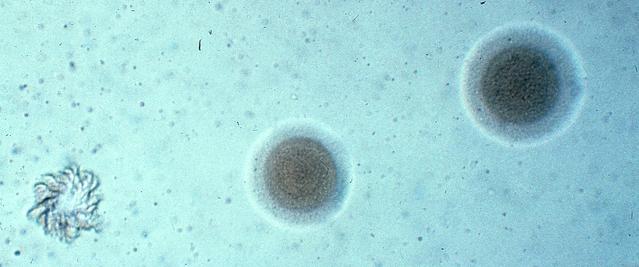The idea of using bugs as tiny drug couriers is not new: scientists have been engineering viruses to deliver medicines and fix genetic defects for some time.However, the potential of viruses is limited because they have a small number of genes and because they do not have an active metabolism of their own and cannot respond to the environment or the host. This limits the scope for their engineering for certain medical purposes.‘Viruses can only carry a limited amount of information,’ said Professor Luis Serrano at the Centre for Genomic Regulation in Barcelona, Spain. ‘They have genes but, unlike bacteria, they do not have a metabolism so they cannot respond to changes in a human cell.’Using bacteria instead of viruses to deliver treatments to specific parts of the body would provide greater scope for fighting disease because they have more genes to tweak.However, bacteria are also significantly more complex to work with. For a start, they typically have cell walls – making it difficult for them to communicate with target cells – and they often draw a strong immune response when implanted into humans.Now, scientists believe they may have found a suitable candidate that has more genes than a virus but is capable of getting into cells to carry out medical missions – and it’s one that we’ve previously associated with disease.PneumoniaMycoplasma pneumoniaecan cause bacterial pneumonia in humans, but also ticks many of the boxes required to become a cell doctor. ‘It has no cell wall, it does not cause major inflammation and it can be grown in the lab,’ explained Prof. Serrano, who studied the bug as part of the CELLDOCTOR project, funded by the EU’s European Research Council (ERC).M. pneumoniaeis also a very small bacterium. It is roughly the size of a mitochondrion – the subcellular powerhouse that provides our cells with energy.Because it is so small and can enter cells without triggering a major immune reaction, Prof. Serrano sees the bug’s potential as a medical tool.“‘We want to engineer bacteria that can get into the human organism, detect anomalies and repair them.’Professor Luis Serrano, Centre for Genomic Regulation, Spain‘We want to engineer a vehicle that can get into the human organism, detect anomalies and repair them,’ he said. ‘It could live inside human cells like a parasite capable of improving health.’Once inside the target cell, the bacterium would blend in with the other structures already there. But unlike the cell’s other subcellular furniture, the engineeredM. pneumoniaebacterium would produce and secrete drugs that a patient needs, or proteins capable of correcting a genetic disease.It would not cause disease itself because the researchers have genetically engineered the pneumoniae bacterium to ensure that it is not infectious.Through the CELLDOCTOR project, Prof. Serrano focused on understanding what makes the bacterium tick before exploring its capacity for delivering drugs, vaccines and genes.By understanding its genetics and biochemistry, the Barcelona-based researchers developed a deeper understanding of the bug – so that they could redesign a simple organism that would act like a living pill.Thanks to additional ERC funding, Prof. Serrano was able to take this work one step further and look at specific uses ofM. pneumoniaefor treating lung and genital tract diseases in a project called MICO PLUNG.‘Our initial work was pointing towards medical applications forM. pneumoniaeand this… project was a chance to direct our efforts towards more clinically applied research,’ he explained.Respiratory disordersThe bacterium is known to live in lung tissue, so researchers are working on how genetically engineered versions of the bug could deliver therapeutic proteins that could fight against infectious respiratory disorders.The team also see potential for bacteria to be used as vaccines, deliberately training the immune system to fight unwelcome viruses and bacteria.Research in this area may change the way we think about bacteria such asM. pneumoniaeby turning an old foe into a valuable ally.Disease-fighting with microbes2012First gene therapy treatment approvedAfter two decades of significant progress in human gene therapy, a treatment delivered by the adeno-associated virus became the first gene therapy to receive EU approval. Known as Glybera, it is used to treat patients with a metabolic disorder called lipoprotein lipase deficiency, which causes inflammation of the pancreas. Work is continuing to develop gene therapies for different conditions and to refine how genetic material is delivered to the patient’s cells, including the possibility of using bacteria.
This article was originally published in Horizon, the EU Research and Innovation magazine.
Add to favorites:
Share:
Listing Description
Video
Documents
No documents available.
Ask KETMarket to make a contact
Connect with the Listing Owner!
💬 Please log in now to askKETMarket to make a contact. Not a member yet? Sign up for free and start connecting today!
Video
Related Funding and Finance Opportunities
Unlock Exclusive Funding Opportunities!
🔑 Get instant access to tailored funding opportunities that perfectly match your needs. This powerful feature is exclusively available to our premium members—helping you save time, stay ahead of the competition, and secure the right funding faster.
Upgrade to Premium now and never miss an important opportunity again! Already a premium member? Log in here to explore your matches.
Related Innovation Offers
Discover Tailored Innovation Offers!
🚀 Gain access to technology solutions that match your specific needs and interests—carefully selected to support your innovation goals. These offers are exclusively available to our premium members, helping you identify relevant technologies faster and start the right conversations with potential partners.
Upgrade to Premium now and explore your personalized technology matches today! Already a premium member? Log in here to view your tailored offers.
Related Knowledgeable Resources
Discover More with Premium: Related Knowledge Resources
🔒 You’re missing out on expert-curated knowledge specifically matched to this topic. As a Premium member, you gain exclusive access to in-depth articles, guides, and insights that help you make smarter decisions, faster.
Whether you’re preparing a funding proposal, researching a new market, or just need reliable information—our Premium knowledge matches save you hours of research and point you directly to what matters.
Upgrade to Premium now and instantly unlock relevant knowledge tailored to your needs! Already a member? Log in here to view your personalized content.

